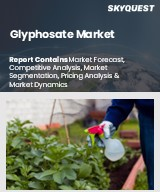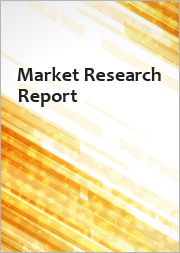
|
시장보고서
상품코드
1635151
세계의 글리포세이트 시장 평가 : 작물 유형별, 형태별, 용도별, 지역별, 기회, 예측(2018-2032년)Glyphosate Market Assessment, By Crop Type [Genetically Modified, Conventional], By Form [Dry, Liquid], By Application [Cereals and Grains, Oilseeds and Pulses, Fruits and Vegetables, Others], By Region, Opportunities and Forecast, 2018-2032F |
||||||
세계의 글리포세이트 시장 규모는 2024년 95억 1,000만 달러에서 2032년에 148억 4,000만 달러에 달할 것으로 예측되며, 2025-2032년의 예측 기간에 CAGR로 5.72%의 성장이 전망됩니다. 글리포세이트는 잡초를 방제하고 작물 생산을 극대화하는 제초제로서 농업에서 중요한 역할을 하고 있습니다. 글리포세이트는 광범위한 스펙트럼을 가진 비선택성 제초제로 옥수수, 콩, 면화, 밀 등의 작물에 널리 사용되어 가장 중요한 제초제 중 하나입니다. 세계 인구, 식량 수요, 농업 효율화에 대한 요구가 증가함에 따라 시장은 앞으로 더욱 성장할 것으로 예상됩니다.
최근 수년간 글리포세이트 내성 유전자 변형 작물은 여러 국가에서 그 수요가 더욱 증가하고 있습니다. 예를 들어 바이엘 호주는 2024년 7월 호주에서 제초제 내성 변종 면화인 XtendFlex 면화를 출시하였습니다. 이 출시는 글리포세이트, 글루포시네이트, 디캄바에 대한 내성을 통해 제조업체에게 잡초 방제 유연성을 향상시키는 것을 목표로 합니다.
그러나 시장은 환경 문제의 심화, 규제 당국의 감시 강화, 유기농업 등의 문제에 직면해 있습니다. 주목할 만한 동향으로는 바이오 대체 농약의 개발과 종합적인 잡초 관리의 실천을 들 수 있습니다.
농업 활동이 활발한 아시아태평양이 가장 활발한 지역입니다. 북미도 큰 기여를 하고 있습니다. 논란과 법적 규제에도 불구하고 글리포세이트는 저렴하고 매우 효과적이기 때문에 대부분의 농가가 가장 먼저 선택하는 제품입니다. 그러나 규제의 발전과 사회적 인식 증가로 인해 시장의 흐름은 향후 수년간 새로운 방향으로 나아갈 것으로 예상됩니다.
세계의 글리포세이트 시장에 대해 조사분석했으며, 시장 규모와 예측, 시장 역학, 주요 기업의 상황 등을 제공하고 있습니다.
목차
제1장 프로젝트 범위와 정의
제2장 조사 방법
제3장 개요
제4장 고객의 소리
- 인구통계(소득 - 저소득, 중소득, 고소득 지역, 국적 등)
- 시장 인지도와 제품 정보
- 브랜드 인지도와 로열티
- 구입 결정에서 고려되는 요소
- 비용 효율
- 잡초 방제의 유효성
- 작물과의 호환성
- 적용의 용이성
- 제제의 가용성
- 환경에 대한 영향
- 규제 준수
- 브랜드 평판
- 제초제 내성에 대한 내성
- 비표적 생물에 대한 안전성
- 농장 규모와 유형
- 제품 가용성과 유통
- 정부의 보조금 또는 장려책
- 제제의 기술적 진보
- 시장 동향과 소비자 선호도
- 구입 채널
- 구입 빈도
- 기존 또는 예정 사용자
제5장 세계의 글리포세이트 시장 전망(2018-2032년)
- 시장 규모 분석과 예측
- 금액
- 시장 점유율 분석과 예측
- 작물 유형별
- 형태별
- 용도별
- 지역별
- 시장 점유율 분석 : 기업별(금액)(상위 5사와 기타 - 2024년)
- 시장 맵 분석(2024년)
- 작물 유형별
- 형태별
- 용도별
- 지역별
제6장 북미의 글리포세이트 시장 전망(2018-2032년)
- 시장 규모 분석과 예측
- 금액
- 시장 점유율 분석과 예측
- 작물 유형별
- 형태별
- 용도별
- 점유율 : 국가별
- 각국의 시장 평가
- 미국의 글리포세이트 시장 전망(2018-2032년)
- 캐나다
- 멕시코
제7장 유럽의 글리포세이트 시장 전망(2018-2032년)
- 독일
- 프랑스
- 이탈리아
- 영국
- 러시아
- 네덜란드
- 스페인
- 터키
- 폴란드
제8장 아시아태평양의 글리포세이트 시장 전망(2018-2032년)
- 인도
- 중국
- 일본
- 호주
- 베트남
- 한국
- 인도네시아
- 필리핀
제9장 남미의 글리포세이트 시장 전망(2018-2032년)
- 브라질
- 아르헨티나
제10장 중동 및 아프리카의 글리포세이트 시장 전망(2018-2032년)
- 사우디아라비아
- 아랍에미리트
- 남아프리카공화국
제11장 규제 상황
제12장 수급 분석
제13장 수입과 수출의 분석
제14장 밸류체인 분석
제15장 Porter's Five Forces 분석
제16장 PESTLE 분석
제17장 거시경제 지표
제18장 가격 분석
제19장 이익률 분석
제20장 시장 역학
- 시장 성장 촉진요인
- 시장이 해결해야 할 과제
제21장 시장의 동향과 발전
제22장 사례 연구
제23장 경쟁 구도
- 시장 리더 상위 5사의 경쟁 매트릭스
- 기업 에코시스템 분석(스타트업 vs. 중소기업 vs. 대기업)
- 상위 5사의 SWOT 분석
- 주요 기업 상위 10사의 상황
- Bayer AG
- FMC Corporation
- Sikko Industries Ltd
- BASF SE
- Nufarm Limited
- UPL Limited
- Adama Agricultural Solutions Limited
- Syngenta Crop Protection AG
- Zhejiang Jinfanda Biochemical Co., Ltd.
- Albaugh LLC
제24장 전략적 추천
제25장 Market Xcel - Markets and Data 소개·면책사항
KSA 25.02.14Global glyphosate market is projected to witness a CAGR of 5.72% during the forecast period 2025-2032, growing from USD 9.51 billion in 2024 to USD 14.84 billion in 2032. It is an important part of the agricultural industry, as glyphosate has proved to be a popular herbicide for weed control and maximizing crop production. It is a broad-spectrum, non-selective herbicide used widely on crops, including corn, soybeans, cotton, and wheat, making it one of the most important herbicides. The market, due to the increasing global population, demand for food, and need for agricultural efficiency, will experience increased growth.
In recent times, glyphosate-resistant genetically modified crops have further escalated their demand in several countries. For instance, in July 2024, Bayer Australia launched its herbicide-tolerant variant of cotton, XtendFlex cotton, in Australia. The launch aimed to provide improved weed control flexibility to growers through tolerance to glyphosate, glufosinate, and dicamba.
However, the market faces challenges, including intensifying environmental concerns, increased regulatory scrutiny, and organic farming. Prominent trends include the development of bio-based alternatives and integrated weed management practices.
Asia-Pacific is the most active region because of the high agricultural activities. North America also contributes enormously. Despite the controversies and legal restrictions, glyphosate remains the first choice of most farmers as it is cheap and very effective. However, market flow is expected to take a new direction in the coming years due to evolving regulations and growing public awareness.
Adoption of Genetically Modified (GM) Crops Catalyzes Market Expansion
Genetically modified (GM) crops that are tolerant to glyphosate are one of the major factors responsible for the booming global glyphosate market. Engineering crops against the broad-spectrum herbicide to eliminate weeds enables the farmers to manage weeds without directly affecting the main crops. This biotechnology is gaining ground in many developed and developing countries. GM crop commodities such as soybeans, corn, and cotton are grown on a large scale in larger economies. By using glyphosate-resistant crops, enhanced operability is gained since one herbicide could be spray-as-needed over one field without having to go over the whole area with different chemicals, therefore cutting costs and reducing manual labor.
Also, enhanced weed control thus leads to increased yield, addressing the need for food, given the growing demand for food due to a rapidly populating world. Considering the need of the hour, in March 2024, Ghana's National Biosafety Authority (NBA) approved 14 new biotechnology products for commercialization. The new genetically engineered products include eight corn and six soybean varieties.
However, debates on issues of environmental sustainability due to herbicide resistance are influencing regulations. However, despite all these debates, the adoption of GM continues to add to the demand for glyphosate, especially in areas where agricultural efficiency is emphasized.
Growing Demand for Glyphosate in Emerging Economies Influences the Market Growth
Emerging markets, especially the Asia-Pacific and South American regions, show steadily increasing demand for glyphosate. These regions are undergoing accelerated agricultural development owing to the increases in the human population and urbanization and the demands for food security. Investments are evident in countries such as India, China, and Brazil, which heavily invest in modernizing agricultural practices so that productivity can increase for local and export markets. One such practice involving glyphosate is the cost-effective means of weed management, a major challenge to large-scale farming.
Farmers in the region rely on glyphosate because of its all-herbicide effect on crop yields and reduced labor work. On the other side, mechanization and intensive farming have increased glyphosate use because it makes weed management easier and less soil disturbing. Governments in these economies also provide financial and capacity-building support to modernize agriculture in the form of subsidized training courses to encourage efficient herbicides like glyphosate. In order to further amend the Insecticides Rules, 1971, the Ministry of Agriculture of India notified the Insecticides (Sixth Amendment) Rules, 2023. As per the amendment, when applying for a license, pest controllers who use only glyphosate and its derivatives in their operations must complete a training program designed specifically for glyphosate usage from a list of institutions. All applicants must complete the 15-day training in order to obtain their training certificate.
Liquid Form Holds the Dominant Market Share
The liquid form of glyphosate dominates all the glyphosate formulations, primarily due to its superb efficacy, application convenience, and adaptability to different farming practices. It makes sense that most farmers prefer these forms because they ensure better coverage and deep penetration of weeds in a wide variety of crops and conditions. These are more compatible with spraying equipment and thus favorable for large-scale agriculture. For instance, New Roundup PowerMAX 3 Herbicide by Bayer AG enables farmers to spray more acres per gallon due to a special surfactant combination that has a greater glyphosate concentration per gallon.
Moreover, the ability to mix with other agricultural inputs, like fertilizers and herbicides, further enhances its performance. Liquid glyphosate is commonly used in the Asia-Pacific for crops like soybeans, corn, and wheat that are grown using intensive farming practices. Fast and reliable across a wide variety of climatic conditions, it can be used safely for pre- and post-emergence weed control. Liquid formulations also save time and labor compared to solid forms in line with modern agricultural practices. Liquid glyphosate is used in spite of strict regulations because of the valid environmental and health concerns associated with it. Therefore, liquid glyphosate is much appreciated for its convenience and effectiveness in addressing the increasing demand for efficient weed control solutions.
Asia-Pacific Being the Fastest Growing Market
Asia-Pacific is the fastest-growing market for glyphosate, driven by expanding agricultural activities, rising food demand, and increasing adoption of modern farming practices. Rapidly growing populations in countries of this region necessitate increased agricultural productivity for food security, increasing the demand for efficient weed-management solutions, such as glyphosate. Such fast-growing countries include China, India, and many Southeast Asian nations due to their massive agricultural outputs and need to improve crop yields. The Institute Control of Agrochemicals, Ministry of Agricultural and Rural Affairs (ICAMA) of the Chinese Ministry of Agriculture and Rural Affairs declared in March 2024 that it plans to authorize the third round of pesticide registrations in 2024. The glyphosate GM crop herbicides are among the pesticides listed in this round of registrations.
Using genetically engineered crops in certain markets, combined with the new mechanized farming trend, further increases the use of glyphosate. Farmers in the region prefer glyphosate for its relatively lower price, ease of application, and wide range of weed control to maximize productivity on limited arable land. Besides, the modernization of agriculture has triggered the use of advanced herbicides with accompanying governmental subsidies and training programs.
Despite regulatory challenges, positive and promising economic growth and technological progress toward improving the region's institutional output-level agricultural productivity further make Asia-Pacific the most important impetus for the global glyphosate market.
Future Market Scenario (2025 - 2032F)
Improvements in novel formulations and enhanced application methods seem to make glyphosate more efficient and safer, thereby lengthening the period of its market relevance.
Increasing environmental worries of modern citizens have inspired consumer preferences for organic farming, which can give rise to bioherbicides and impact glyphosate use patterns.
Farmers are expected to use integrated weed control practices by applying glyphosate alongside other sustainable techniques to deal with herbicide resistance.
Key Players Landscape and Outlook
A competitive landscape in the glyphosate market comprises a number of key players, regional companies, and small start-ups that address increasing international demand. These leading enterprises emphasize high-quality, useful formulations, including liquid and granular types, with the objective of addressing application diversity in agriculture. The strong R&D innovation that propels advanced glyphosate formulation coupled with efficient weed control and minimal environmental concerns will certainly advance the intensifying levels of competitiveness.
Companies are investing in expanding production capacities, especially in the fast-growing regions of Asia-Pacific and South America, due to the increasing agricultural activities in these regions. Partnerships with distributors and strategic collaborations are expected to strengthen the supply chains and expand in emerging markets. For instance, in March 2023, Albaugh LLC acquired the glyphosate business of Corteva Agriscience. With this acquisition, the company aims to increase its global coverage of direct glyphosate DMA salt formulations and registrations.
Investments are also attuned to developments for meeting the rising regulatory scrutiny, as companies tend to come up with more eco-friendly alternatives and integrated weed management solutions.
Glyphosate demand will increase exponentially in the future, as it will also be projected in emerging regions due to increasing food requirements and agricultural mechanization. However, developed markets will show slower growth rates due to increasing regulatory pressures and a shift to sustainable farming. Innovative business models, market diversification, and a competent ability to deal with herbicide resistance will lead to competition in this evolving scenario.
Table of Contents
1. Project Scope and Definitions
2. Research Methodology
3. Executive Summary
4. Voice of Customer
- 4.1. Demographics (Income - Low, Mid and High; Geography; Nationality; etc.)
- 4.2. Market Awareness and Product Information
- 4.3. Brand Awareness and Loyalty
- 4.4. Factors Considered in Purchase Decision
- 4.4.1. Cost-effectiveness
- 4.4.2. Effectiveness in Weed Control
- 4.4.3. Compatibility with Crops
- 4.4.4. Ease of Application
- 4.4.5. Availability of Formulations
- 4.4.6. Environmental Impact
- 4.4.7. Regulatory Compliance
- 4.4.8. Brand Reputation
- 4.4.9. Resistance to Herbicide Resistance
- 4.4.10. Safety for Non-Target Organisms
- 4.4.11. Farm Size and Type
- 4.4.12. Product Availability and Distribution
- 4.4.13. Government Subsidies or Incentives
- 4.4.14. Technological Advancements in Formulation
- 4.4.15. Market Trends and Consumer Preferences
- 4.5. Purchase Channel
- 4.6. Frequency of Purchase
- 4.7. Existing or Intended User
5. Global Glyphosate Market Outlook, 2018-2032F
- 5.1. Market Size Analysis & Forecast
- 5.1.1. By Value
- 5.2. Market Share Analysis & Forecast
- 5.2.1. By Crop Type
- 5.2.1.1. Genetically Modified
- 5.2.1.2. Conventional
- 5.2.2. By Form
- 5.2.2.1. Dry
- 5.2.2.2. Liquid
- 5.2.3. By Application
- 5.2.3.1. Cereals and Grains
- 5.2.3.2. Oilseeds and Pulses
- 5.2.3.3. Fruits and Vegetables
- 5.2.3.4. Others
- 5.2.4. By Region
- 5.2.4.1. North America
- 5.2.4.2. Europe
- 5.2.4.3. Asia-Pacific
- 5.2.4.4. South America
- 5.2.4.5. Middle East and Africa
- 5.2.5. By Company Market Share Analysis (Top 5 Companies and Others - By Value, 2024)
- 5.2.1. By Crop Type
- 5.3. Market Map Analysis, 2024
- 5.3.1. By Crop Type
- 5.3.2. By Form
- 5.3.3. By Application
- 5.3.4. By Region
6. North America Glyphosate Market Outlook, 2018-2032F*
- 6.1. Market Size Analysis & Forecast
- 6.1.1. By Value
- 6.2. Market Share Analysis & Forecast
- 6.2.1. By Crop Type
- 6.2.1.1. Genetically Modified
- 6.2.1.2. Conventional
- 6.2.2. By Form
- 6.2.2.1. Dry
- 6.2.2.2. Liquid
- 6.2.3. By Application
- 6.2.3.1. Cereals and Grains
- 6.2.3.2. Oilseeds and Pulses
- 6.2.3.3. Fruits and Vegetables
- 6.2.3.4. Others
- 6.2.4. By Country Share
- 6.2.4.1. United States
- 6.2.4.2. Canada
- 6.2.4.3. Mexico
- 6.2.1. By Crop Type
- 6.3. Country Market Assessment
- 6.3.1. United States Glyphosate Market Outlook, 2018-2032F*
- 6.3.1.1. Market Size Analysis & Forecast
- 6.3.1.1.1. By Value
- 6.3.1.2. Market Share Analysis & Forecast
- 6.3.1.2.1. By Crop Type
- 6.3.1.2.1.1. Genetically Modified
- 6.3.1.2.1.2. Conventional
- 6.3.1.2.2. By Form
- 6.3.1.2.2.1. Dry
- 6.3.1.2.2.2. Liquid
- 6.3.1.2.3. By Application
- 6.3.1.2.3.1. Cereals and Grains
- 6.3.1.2.3.2. Oilseeds and Pulses
- 6.3.1.2.3.3. Fruits and Vegetables
- 6.3.1.2.3.4. Others
- 6.3.1.2.1. By Crop Type
- 6.3.1.1. Market Size Analysis & Forecast
- 6.3.2. Canada
- 6.3.3. Mexico
- 6.3.1. United States Glyphosate Market Outlook, 2018-2032F*
All segments will be provided for all regions and countries covered
7. Europe Glyphosate Market Outlook, 2018-2032F
- 7.1. Germany
- 7.2. France
- 7.3. Italy
- 7.4. United Kingdom
- 7.5. Russia
- 7.6. Netherlands
- 7.7. Spain
- 7.8. Turkey
- 7.9. Poland
8. Asia-Pacific Glyphosate Market Outlook, 2018-2032F
- 8.1. India
- 8.2. China
- 8.3. Japan
- 8.4. Australia
- 8.5. Vietnam
- 8.6. South Korea
- 8.7. Indonesia
- 8.8. Philippines
9. South America Glyphosate Market Outlook, 2018-2032F
- 9.1. Brazil
- 9.2. Argentina
10. Middle East and Africa Glyphosate Market Outlook, 2018-2032F
- 10.1. Saudi Arabia
- 10.2. UAE
- 10.3. South Africa
11. Regulatory Landscape
12. Demand Supply Analysis
13. Import and Export Analysis
14. Value Chain Analysis
15. Porter's Five Forces Analysis
16. PESTLE Analysis
17. Macro-economic Indicators
18. Pricing Analysis
19. Profit Margin Analysis
20. Market Dynamics
- 20.1. Market Drivers
- 20.2. Market Challenges
21. Market Trends and Developments
22. Case Studies
23. Competitive Landscape
- 23.1. Competition Matrix of Top 5 Market Leaders
- 23.2. Company Ecosystem Analysis (Startup v/s SME v/s Large-scale)
- 23.3. SWOT Analysis for Top 5 Players
- 23.4. Key Players Landscape for Top 10 Market Players
- 23.4.1. Bayer AG
- 23.4.1.1. Company Details
- 23.4.1.2. Key Management Personnel
- 23.4.1.3. Products and Services
- 23.4.1.4. Financials (As Reported)
- 23.4.1.5. Key Market Focus and Geographical Presence
- 23.4.1.6. Recent Developments/Collaborations/Partnerships/Mergers and Acquisition
- 23.4.2. FMC Corporation
- 23.4.3. Sikko Industries Ltd
- 23.4.4. BASF SE
- 23.4.5. Nufarm Limited
- 23.4.6. UPL Limited
- 23.4.7. Adama Agricultural Solutions Limited
- 23.4.8. Syngenta Crop Protection AG
- 23.4.9. Zhejiang Jinfanda Biochemical Co., Ltd.
- 23.4.10. Albaugh LLC
- 23.4.1. Bayer AG
Companies mentioned above DO NOT hold any order as per market share and can be changed as per information available during research work.



















